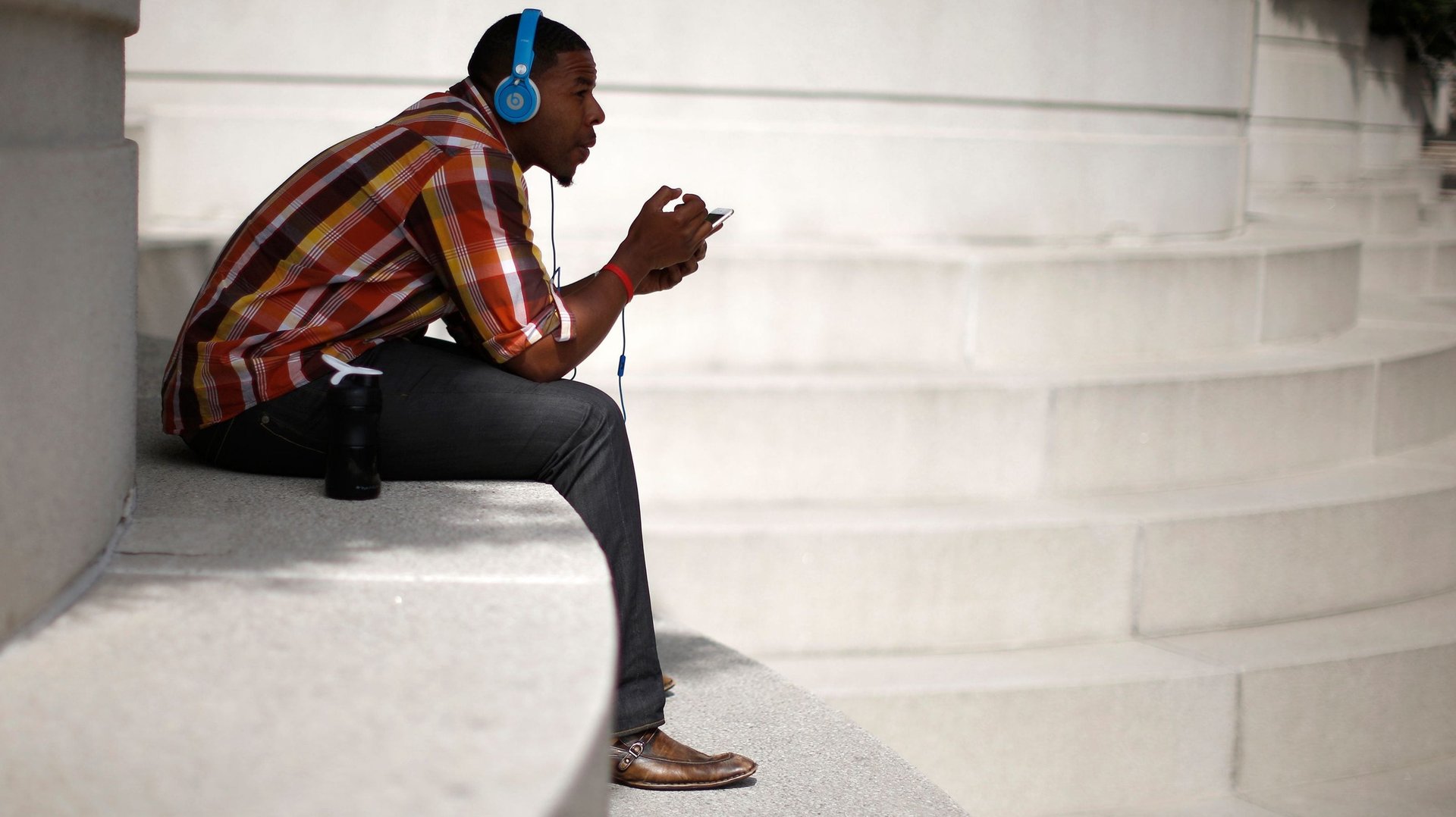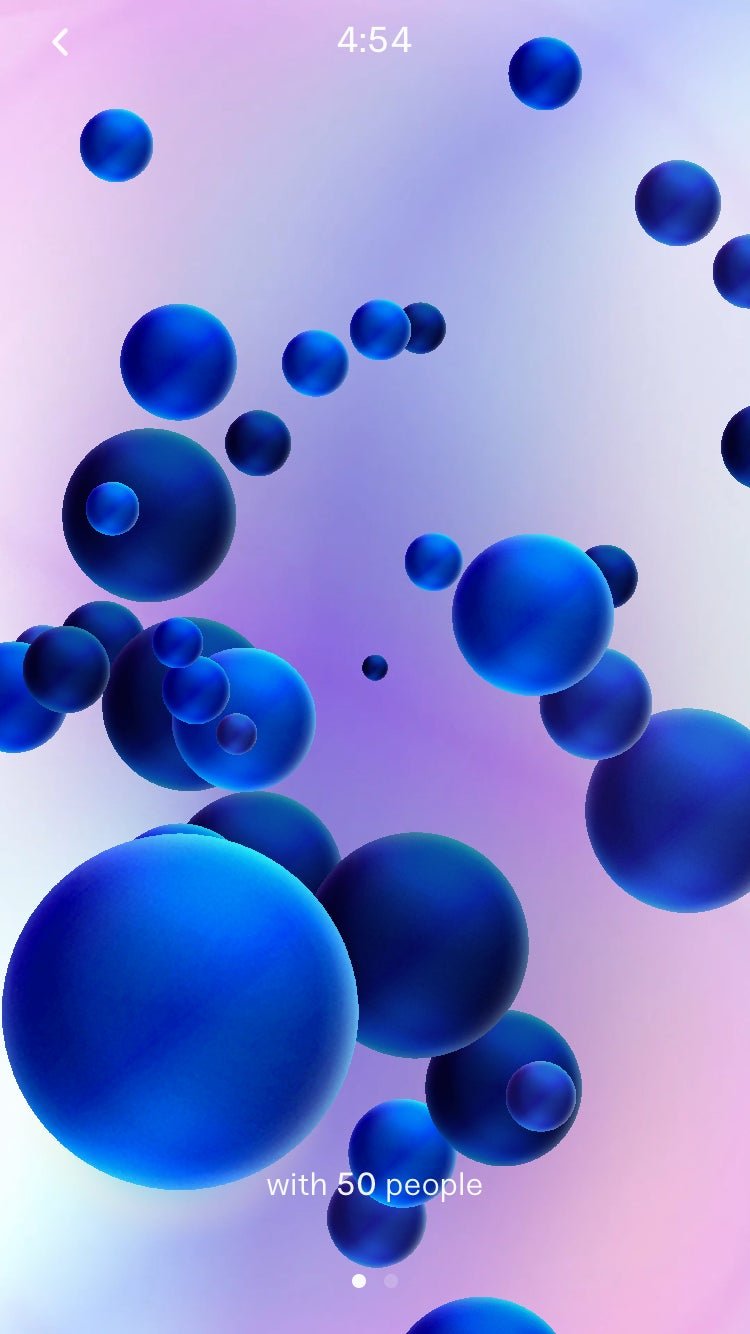There’s a new way to meditate at work
Every weekday, just before 3pm, my phone buzzes with a notification to “tap in” or “check in” or “breathe together.” Most days, I obey.


Every weekday, just before 3pm, my phone buzzes with a notification to “tap in” or “check in” or “breathe together.” Most days, I obey.
I look for a private, comfortable place to sit, preferably stepping away from my desk, open the “Tap In” app on my mobile phone, put on my headset, and wait for a 10-minute live meditation session to begin. For a minute or so, I watch a blue orb “breathe” on a home screen tinted the pink and blue shades of dusk, accompanied by a soundtrack of chimes. When the instructor suddenly cuts in with a greeting, it’s invariably a little jolting.
But that human—not a robot, not a recording—speaking in real time is the reason I keep returning. The instructor could be nearby in New York, or in Boulder, Colorado, or somewhere in California, but the sound is crisp and clear. As I close my eyes, I imagine the 50 to 100 others who may also be on the app doing the same thing, at the same moment. On screen, several blue orbs will have gathered to float in random patterns.

Tap In is the first live meditation app, according to its creator, Margaux Le Pierrès, a graphic designer and reiki practitioner in Brooklyn. It’s made for any user, but especially for today’s distributed workforce, by Fictive Kin, a digital studio specializing in products and branding, and Le Pierrès’ employer. “People ask ‘How do you make money?’ And the answer is, ‘Well, we don’t,’” she says. The app is meant to make meditation available to all.
Its existence is owed to a couple of office-wide experiments. Fictive Kin owner Cameron Koczon had asked his employees to propose products they could make as a gift to themselves, something that would represent the team’s culture and worldview. At a brainstorming lunch one day, he suggested a live meditation app. Le Pierrès scoffed. “I was like ‘Oh no, people really need to sit together. The nuances of the practice won’t be able to be communicated,’” she recalls. “And then we just kind of left it.”
A few weeks later, after a reiki retreat in Mexico, Le Pierrès felt inspired to bring some of her personal wellness practice into the office, to bridge her two worlds, she says. She started Friday lunchtime mediation. Rather than cue an app of recorded meditations like the popular apps Headspace or 10% Happier, however, she led the sittings over a conference call so that peers in remote offices could join.
“It’s the weirdest thing. When we meditate, it feels like you guys are there,” a colleague in Seattle told her in a chat message one day. “She said ‘My mind doesn’t spiral in the same way as when I sit alone and try guided meditation,” Le Pierrès recalls.
“I sometimes fall on the woo woo spectrum, and my thinking about what’s possible is a little bit more over there,” she says, over coffee in New York, gesturing off to the side. “So I was feeling people. But when I heard that co-worker say that, I realized this is real for everyone.”
There’s a sense of community that comes from being present in the time-bound event, even though your fellow meditators are not in the room, she believes. “Our brains fill that in for you,” says the designer. Discovering what she calls “the power and the heart behind this idea,” she went to her boss and said, “We need to do this.”
It took about seven months of side-hustle hours to build the minimalist Tap In interface and to recruit the teachers—paid instructors who come from various Buddhist lineages— to lead the sessions. The iPhone app debuted in February, and the Android version is in development.
Le Pierrès likes to joke that Tap In is an app that does nothing. As befits a product that encourages a quiet turning inwards, it rejects “the vernacular of swiping, liking, or scrolling,” that can lead to a kind of mindlessness, she explains.
The sessions are truly impermanent, too, to emphasize the present moment. They’re not stored in a file somewhere. If you miss the 10-minute meditation, you’ll have to come back tomorrow. Admittedly, this makes it less convenient than on-demand meditation apps, but it also captures the spirit of the practice.

Le Pierrès chose 3pm eastern time because it’s when the mind’s ability to focus dips, for most people in her time zone. It’s the time of day when you might crave a caffeinated drink or a cookie. But that timing also makes it doable for people across the US to take a breather during their workdays, too, while users in Europe can, and do, “tap in” before going to bed. Le Pierrès has even spotted people joining in from the Middle East, where it would be midnight.
It’s truly ideal for teams that don’t share a physical space to meet in this one, which Le Pierrès calls “basically the biggest meditation studio in the world.”
She’s hoping the app will continue growing for a year, and that it will remain free. And the popularity of similar concepts, like live-streaming workouts on Peloton, suggest it could take off. But the only revenue model she has considered involves approaching companies and offering slightly tailored versions of Tap In on private channels for employees, including those who are remote. She’s wondering whether she would need to have CEOs approve the activity, to send out a message that says, “Hey, this is acceptable. If if I see you at your desk at 3pm with your eyes closed, that’s totally cool.” (Fortunately, there’s data available for her to make the case that even short bursts of meditation are correlated with lower levels of stress and anxiety, better heart health, and more restful sleep.)
When I recommended the app to one of my co-workers, she responded with incredulity, asking, essentially, “Who has time for this in the middle of the afternoon?”
But that’s exactly the point. Arguably, the brain needs a break and a shift away from autopilot when it’s at its busiest. Your mind requires that space if you want some insight into the day you’re having, or some room to think creatively, or a moment to recognize the tension in your jaw. You may want to reconnect briefly with a deeper emotion you’re suppressing. And you may need the support of a ritual, involving others, to make it a habit.
In a live event, the possibility of the instructor making a mistake, or having a curious cat bump the microphone, is very real, says Le Pierrès. During one session, a coach confessed that he was feeling particularly scattered that day with “fragments of thoughts” and pieces of the news circulating in his mind. His micro dharma talk was reassuringly relatable. On the day Notre Dame was burning, the instructor acknowledged a collective sadness.
But mostly the broadcast offers a different luxury: silence. Intentional, shared silence, like the naps you would take in kindergarten or silent reading time in grade school. Indeed, the one piece of consistent feedback that Le Pierrès has received is that users would like even more of it.